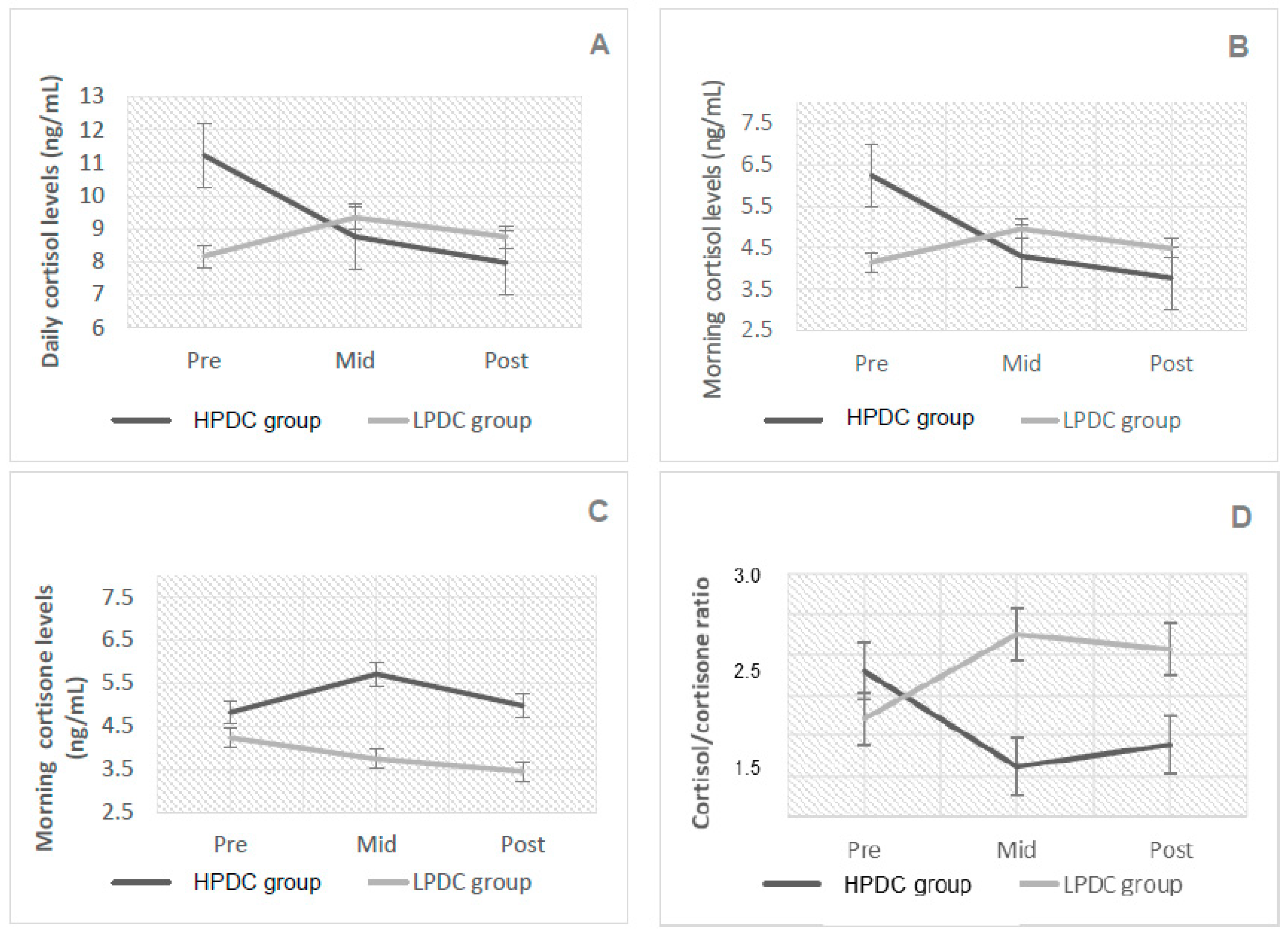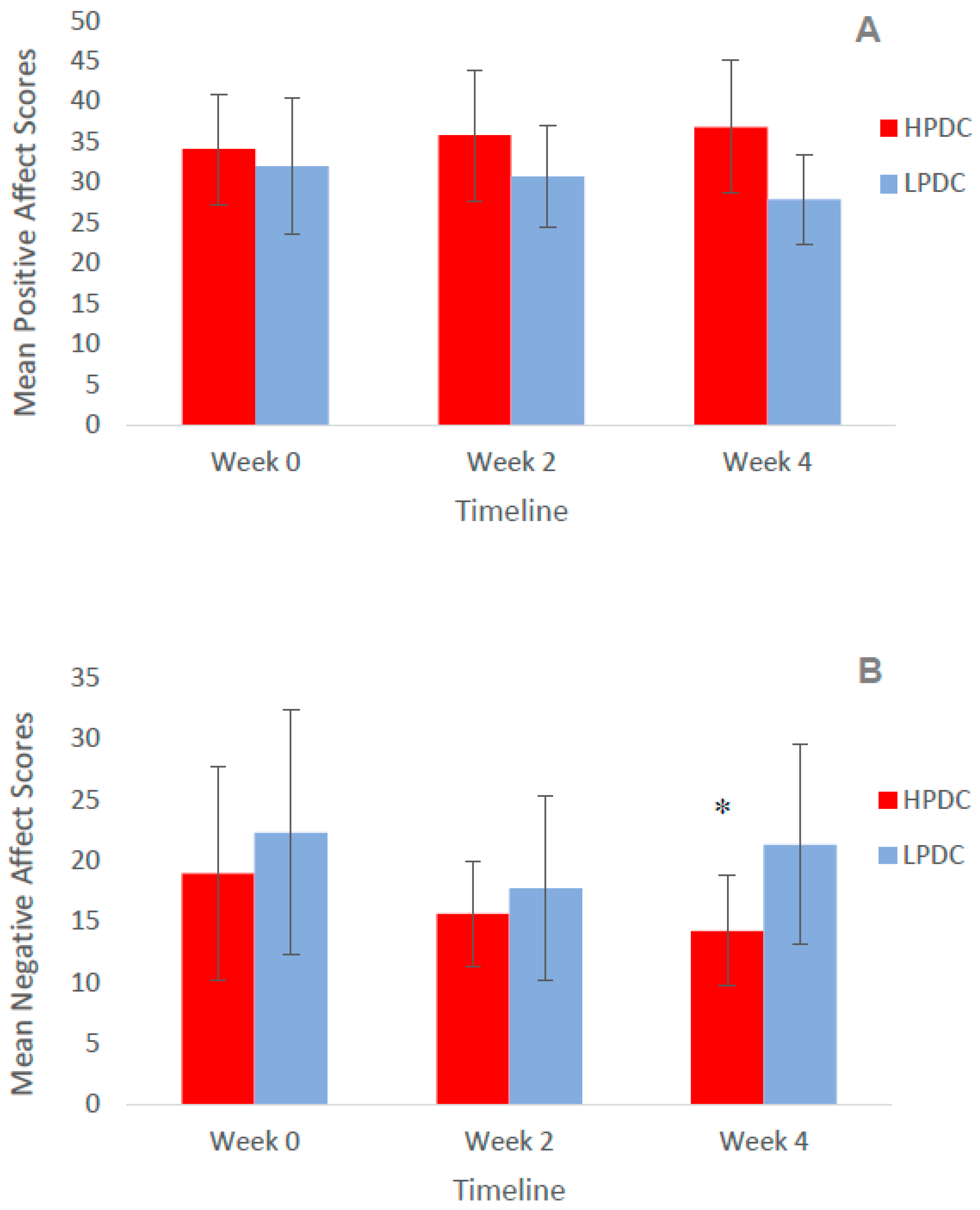Effect of Polyphenol-Rich Dark Chocolate on Salivary Cortisol and Mood in Adults
Abstract
1. Introduction
2. Materials and Methods
2.1. Participants
2.2. Study Design
2.3. Experimental Procedures
2.4. Data Processing, Analyses, and Statistics
3. Results
3.1. Anthropometric Indices and Blood Pressure
3.2. Glucocorticoid Levels
3.3. Subjective Mood (PANAS)
4. Discussion
5. Conclusions
Author Contributions
Funding
Acknowledgments
Conflicts of Interest
Abbreviations
| ACTH | Adrenocorticotropic hormone |
| BMI | Body mass index |
| BP | Blood pressure |
| BOS | Burn out syndrome |
| CVD | Cardiovascular disease |
| DBP | Diastolic blood pressure |
| DC | Dark chocolate |
| ELISA | Enzyme-linked immunosorbent assay |
| GABA | Gamma-amino butyric acid |
| GC | Glucocorticoid |
| 11β-HSD | 11β-hydroxysteroid dehydrogenase |
| HPA | Hypothalamic–pituitary–adrenal axis |
| HPDC | High polyphenol dark chocolate |
| LPDC | Low polyphenol dark chocolate |
| MOA | Monoamine oxidase |
| NA | Negative affect |
| PANAS | Positive affect and negative affect schedule |
| PA | Positive affect |
| SBP | Systolic blood pressure |
References
- Basu, S.; Qayyum, H.; Mason, S. Occupational stress in the ED: A systematic literature review. Emerg. Med. J. 2017, 34, 441–447. [Google Scholar] [CrossRef]
- Sudhir, P.M.; Sharma, M.P.; Mariamma, P.; Subbakrishna, D.K. Quality of life in anxiety disorders: Its relation to work and social functioning and dysfunctional cognitions: An exploratory study from India. Asian J. Psychiatry 2012, 5, 309–314. [Google Scholar] [CrossRef] [PubMed]
- Health and Safety Executive, 2017. Available online: www.hse.gov.uk/statistics (accessed on 1 March 2019).
- Wallang, P.; Ellis, R. Stress, Burnout and resilience and the HCA. Br. J. Healthc. Assist. 2017, 11, 273–275. [Google Scholar] [CrossRef]
- Elshaer, N.S.M.; Moustafa, M.S.A.; Aiad, M.W.; Ramadan, M.I.E. Job Stress and Burnout Syndrome among Critical Care Healthcare Workers. Alexandria J. Med. 2018, 54, 273–277. [Google Scholar] [CrossRef]
- Fischer, S.; Macare, C.; Cleare, A.J. Hypothalamic–pituitary–adrenal (HPA) axis functioning as predictor of antidepressant response–meta-analysis. Neurosci. Biobehav. Rev. 2017, 83, 200–211. [Google Scholar] [CrossRef]
- Stephens, M.A.C.; Mahon, P.M.; Mc Caul, M.C.; Wand, G.S. Hypothalamic–pituitary–adrenal axis response to acute psychosocial stress: Effects of biological sex and circulating sex hormones. Psychoneuroendocrinology 2016, 66, 47–55. [Google Scholar] [CrossRef]
- Girdler, S.S.; Lindgren, M.; Porcu, P.; Rubinow, D.R.; Johnson, J.L.; Morrow, A.L. A history of depression in women is associated with an altered GABAergic neuroactive steroid profile. Psychoneuroendocrinology 2012, 37, 543–553. [Google Scholar] [CrossRef]
- Petrowski, K.; Herold, U.; Joraschky, P.; Wittchen, H.U.; Kirschbaum, C. A striking pattern of cortisol non-responsiveness to psychosocial stress in patients with panic disorder with concurrent normal cortisol awakening responses. Psychoneuroendocrinology 2010, 35, 414–421. [Google Scholar] [CrossRef] [PubMed]
- Stephens, M.A.; Wand, G. Stress and the HPA axis: role of glucocorticoids in alcohol dependence. Alcohol Res. 2012, 34, 468–483. [Google Scholar]
- Tsigos, C.; Chrousos, G.P. Hypothalamic–pituitary–adrenal axis, neuroendocrine factors and stress. J. Psychosom. Res. 2002, 53, 865–871. [Google Scholar] [CrossRef]
- Saura-Calixto, F.; Goni, I. Definition of the Mediterranean diet based on bioactive compounds. Crit. Rev. Food Sci. Nutr. 2009, 49, 145–152. [Google Scholar] [CrossRef] [PubMed]
- Miller, M.G.; Shukitt-Hale, B. Berry fruit enhances beneficial signalling in the brain. J. Agric. Food Chem. 2012, 60, 5709–5715. [Google Scholar] [CrossRef] [PubMed]
- Ahmad, M.S.; Sheeba, M.; Ali, A.; Yadav, R.; Gautam, B. Anti-mutagenic Effects of Flavonoids in Human Lymphocytes Culture. Trends Biosci. 2009, 2, 27–30. [Google Scholar]
- Mao, T.; Van De Water, J.; Keen, C.L.; Schmitz, H.H.; Gershwin, M.E. Cocoa procyanidins and human cytokine transcription and secretion. J. Nutr. 2000, 130, 2093S–2099S. [Google Scholar] [CrossRef]
- Vita, J.A. Polyphenols and cardiovascular disease: Effects on endothelial and platelet function. Am. J. Clin. Nutr. 2005, 81, 292S–297S. [Google Scholar] [CrossRef] [PubMed]
- An, L.; An, Y.Z.; Zhang, N.J.; Yu, X.; Liu, M.; Zhao, N.; Yuan, L. The total flavonoids extracted from Xiaobuxin Tang up-regulate the decreased hippocampal neurogenesis and neurotrophic molecules expression in chronically stressed rats. Prog. Neuro-Psychopharmacol. Biol. Psychiatry 2008, 32, 1484–1490. [Google Scholar] [CrossRef] [PubMed]
- An, L.; Zhang, N.J.; Liu, M.; Yu, N.J.; Chen, H.X.; Zhao, N.; Yuan, L. Total flavonoids extracted from Xiaobuxin-Tang on the hyperactivity of hypothalamic–pituitary–adrenal axis in chronically stressed rats. Evid.-Based Complement. Altern. Med. 2011, 1–7. [Google Scholar] [CrossRef]
- Smith, D.F. Benefits of flavanol-rich cocoa-derived products for mental well-being: A review. J. Funct. Foods 2013, 5, 10–15. [Google Scholar] [CrossRef]
- Ratnasooriya, W.D.; Fernando, T.S.P.; Ranatunga, R.A.A.R. Anxiolytic activity of hot water brew of Sri Lankan black tea (Camellia sinensis L.) in rats. Aust. J. Med. Herb. 2007, 19, 178–187. [Google Scholar]
- Young, E.A.; Abelson, J.L.; Cameron, O.G. Effect of comorbid anxiety disorders on the hypothalamic–pituitary–adrenal axis response to a social stressor in major depression. Biol. Psychiatry 2004, 56, 113–120. [Google Scholar] [CrossRef] [PubMed]
- Sathyapalan, T.; Beckett, S.; Rigby, A.S.; Mellor, D.D.; Atkin, S.L. High cocoa polyphenol rich chocolate may reduce the burden of the symptoms in chronic fatigue syndrome. Nutr. J. 2010, 9, 55. [Google Scholar] [CrossRef] [PubMed]
- Khalid, S.; Barfoot, K.; May, G.; Lamport, D.; Reynolds, S.; Williams, C. Effects of Acute Blueberry Flavonoids on Mood in Children and Young Adults. Nutrients 2017, 9, 158. [Google Scholar] [CrossRef]
- Scholey, A.B.; French, S.J.; Morris, P.J.; Kennedy, D.O.; Milne, A.L.; Haskell, C.F. Consumption of cocoa flavanols results in acute improvements in mood and cognitive performance during sustained mental effort. J. Psychopharmacol. 2010, 24, 1505–1514. [Google Scholar] [CrossRef]
- Pase, M.P.; Scholey, A.B.; Pipingas, A.; Kras, M.; Nolidin, K.; Gibbs, A.; Wesnes, K.; Stough, C. Cocoa polyphenols enhance positive mood states but not cognitive performance: A randomized, placebo-controlled trial. J. Psychopharmacol. 2013, 27, 451–458. [Google Scholar] [CrossRef]
- Grassi, D.; Lippi, C.; Necozione, S.; Desideri, G.; Ferri, C. Short-term administration of dark chocolate is followed by a significant increase in insulin sensitivity and a decrease in blood pressure in healthy persons. Am. J. Clin. Nutr. 2005, 81, 611–614. [Google Scholar] [CrossRef] [PubMed]
- Watson, D.; Clark, L.A.; Tellegen, A. Development and validation of brief measures of positive and negative affect: the PANAS scales. J. Person. Soc. Psychol. 1988, 54, 1063. [Google Scholar] [CrossRef]
- Baghdadi, H.; Al-Dujaili, E.; Almoosawi, S.; Howie, F.; Mason, I. Application of a highly specific and sensitive ELISA for the estimation of cortisone in biological fluids. Endo Abstr. 2010, 16, 152. [Google Scholar]
- Palermo, M.; Shackleton, C.H.; Mantero, F.; Stewart, P.M. Urinary free cortisone and the assessment of 11β-hydroxysteroid dehydrogenase activity in man. Clin. Endocrinol. 1996, 45, 605–611. [Google Scholar] [CrossRef]
- Newton, R. Molecular mechanisms of glucocorticoid action: What is important? Thorax 2000, 55, 603–613. [Google Scholar] [CrossRef]
- Masuzaki, H.; Paterson, J.; Shinyama, H.; Morton, N.M.; Mullins, J.J.; Seckl, J.R. A transgenic model of visceral obesity and the metabolic syndrome. Science 2001, 294, 2166–2170. [Google Scholar] [CrossRef] [PubMed]
- Keller, J.; Gomez, R.; Williams, G.; Lembke, A.; Lazzeroni, L.; Murphy Jr, G.M.; Schatzberg, A.F. HPA axis in major depression: cortisol, clinical symptomatology and genetic variation predict cognition. Mol. Psychiatry 2017, 22, 527. [Google Scholar] [CrossRef] [PubMed]
- Almoosawi, S.; Tsang, C.; Ostertag, L.M.; Fyfe, L.; Al-Dujaili, E.A. Differential effect of polyphenol-rich dark chocolate on biomarkers of glucose metabolism and cardiovascular risk factors in healthy, overweight and obese subjects: a randomized clinical trial. Food Funct. 2012, 3, 1035–1043. [Google Scholar] [CrossRef]
- Lee, Y.S.; Lorenzo, B.J.; Koufis, T.; Reidenberg, M.M. Grapefruit juice and its flavonoids inhibit 11β-hydroxysteroid dehydrogenase. Clin. Pharmacol. Ther. 1996, 59, 62–71. [Google Scholar] [CrossRef]
- Zhu, J.T.; Choi, R.C.; Chu, G.K.; Cheung, A.W.; Gao, Q.T.; Li, J.; Jiang, Z.Y.; Dong, T.T.; Tsim, K.W. Flavonoids possess neuroprotective effects on cultured pheochromocytoma PC12 cells: A comparison of different flavonoids in activating estrogenic effect and in preventing β-amyloid-induced cell death. J. Agric. Food Chem. 2007, 55, 2438–2445. [Google Scholar] [CrossRef] [PubMed]
- Chapman, K.; Holmes, M.; Seckl, J. 11β-hydroxysteroid dehydrogenases: Intracellular gatekeepers of tissue glucocorticoid action. Physiol. Rev. 2013, 93, 1139–1206. [Google Scholar] [CrossRef] [PubMed]


| Variable | HPDC Group | LPDC Group | ||||
|---|---|---|---|---|---|---|
| Pre | Mid | Post | Pre | Mid | Post | |
| Body mass (kg) | 73.4 ± 17.9 | 69.2 ± 24.3 | 73.3 ± 17.5 | 75.4 ± 23.7 | 75.2 ± 23.6 | 76 ± 24.5 |
| BMI (kg/m2) | 26.8 ± 5.8 | 25.1 ± 8.3 | 26.8 ± 5.6 | 27.2 ± 6.7 | 27.0 ± 6.6 | 27.1 ± 6.8 |
| SBP (mmHg) | 106.7 ± 9.2 | 106.5 ± 9.9 | 107.6 ± 13.1 | 97.8 ± 8.8 | 102.4± 9.7 | 99.6 ± 7.7 |
| DBP (mmHg) | 69.4 ± 7.5 | 72.3 ± 6.9 | 72.2 ± 7.1 | 65.6 ± 10.7 | 72.8 ± 8.6 | 68.3 ± 6.3 |
© 2019 by the authors. Licensee MDPI, Basel, Switzerland. This article is an open access article distributed under the terms and conditions of the Creative Commons Attribution (CC BY) license (http://creativecommons.org/licenses/by/4.0/).
Share and Cite
Tsang, C.; Hodgson, L.; Bussu, A.; Farhat, G.; Al-Dujaili, E. Effect of Polyphenol-Rich Dark Chocolate on Salivary Cortisol and Mood in Adults. Antioxidants 2019, 8, 149. https://doi.org/10.3390/antiox8060149
Tsang C, Hodgson L, Bussu A, Farhat G, Al-Dujaili E. Effect of Polyphenol-Rich Dark Chocolate on Salivary Cortisol and Mood in Adults. Antioxidants. 2019; 8(6):149. https://doi.org/10.3390/antiox8060149
Chicago/Turabian StyleTsang, Catherine, Lindsay Hodgson, Anna Bussu, Grace Farhat, and Emad Al-Dujaili. 2019. "Effect of Polyphenol-Rich Dark Chocolate on Salivary Cortisol and Mood in Adults" Antioxidants 8, no. 6: 149. https://doi.org/10.3390/antiox8060149
APA StyleTsang, C., Hodgson, L., Bussu, A., Farhat, G., & Al-Dujaili, E. (2019). Effect of Polyphenol-Rich Dark Chocolate on Salivary Cortisol and Mood in Adults. Antioxidants, 8(6), 149. https://doi.org/10.3390/antiox8060149







